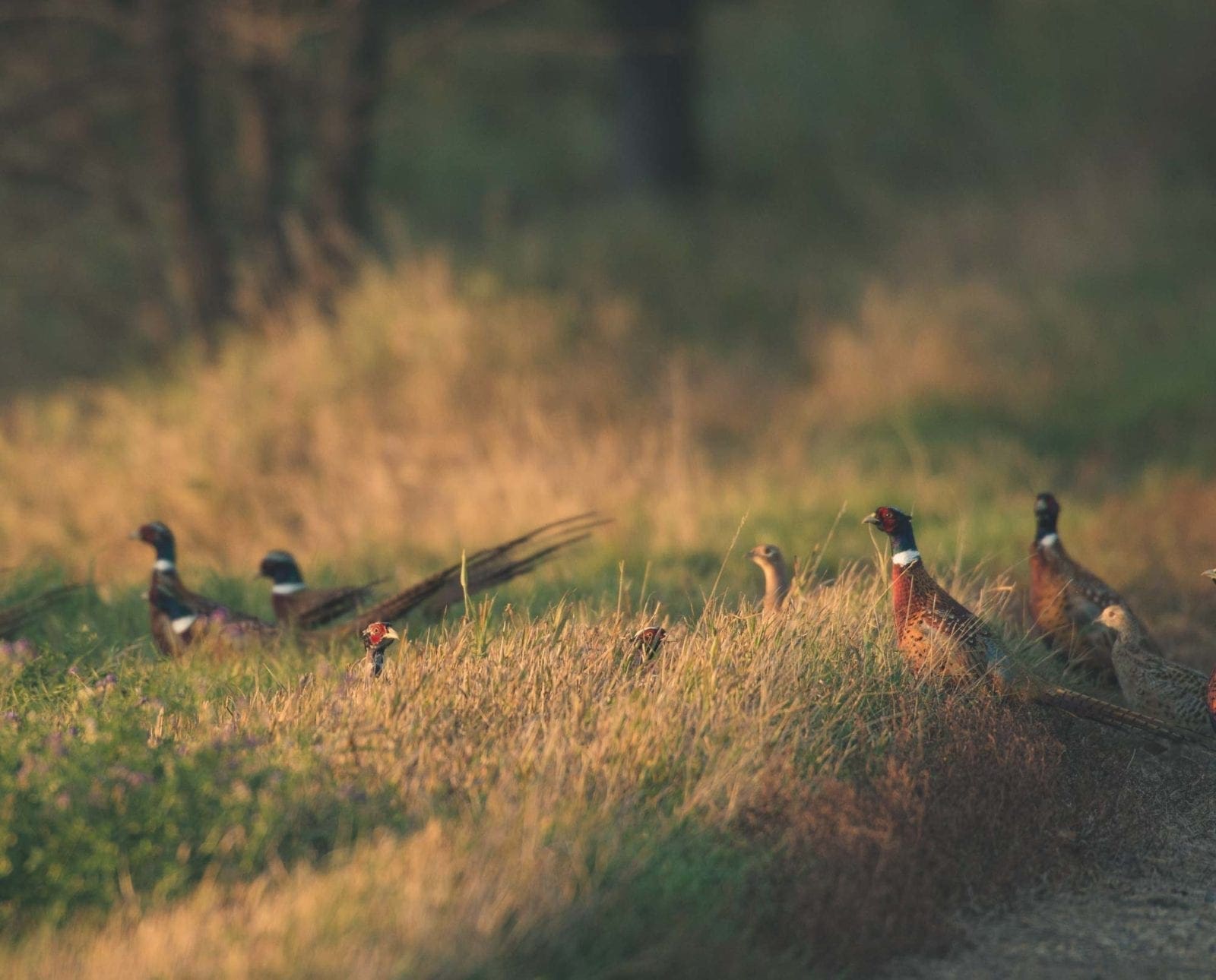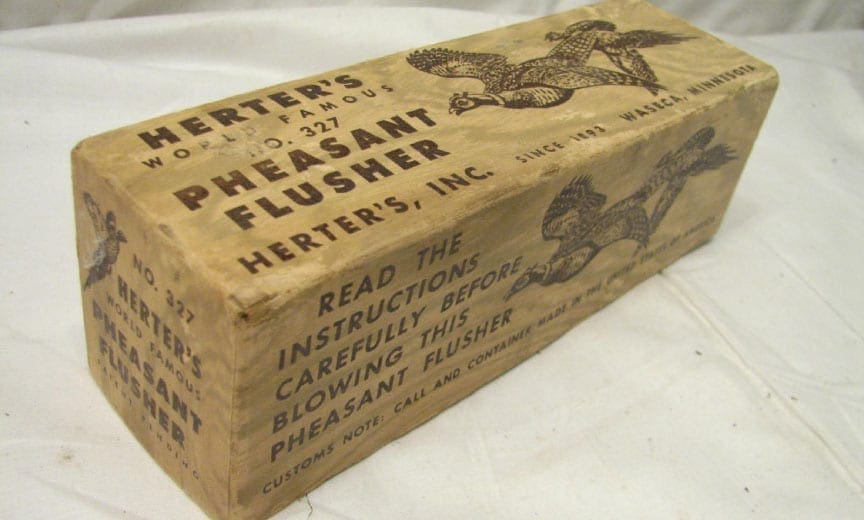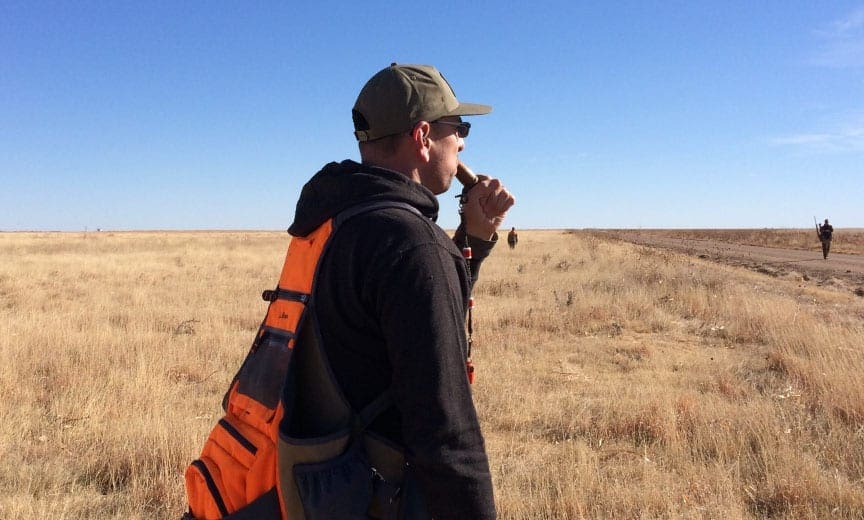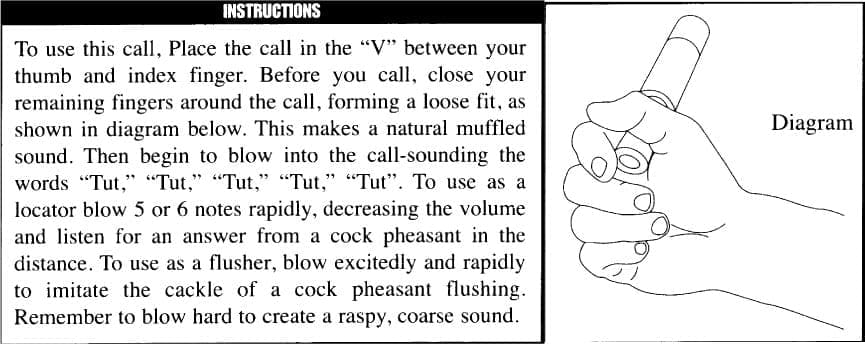
Edgar Castillo is a recently retired law enforcement officer for…
Is the pheasant call an upland myth?
Locating ring-necked pheasants and then getting them to flush at just the right moment are two of the greatest challenges of pheasant hunting. Throw in a wooden pheasant call and …
Wait, what did you just say? A pheasant call? I know what you’re thinking. Can it be done? Hell, I’m skeptical! I will probably be laughed at for even bringing this topic to light, let alone trying to sell the idea.
Let me put your fears at rest: I am by no means trying to persuade any pheasant hunters that this is a tried and true tactic. I am merely pondering the idea and using field situations to ascertain the usefulness and validity of the pheasant call.
Pheasant calls have been around since the early part of the 20th century. Manufacturers like Mallardtone have been making and selling pheasant calls since 1946. Their wooden pheasant calls claim to imitate the cackle of the cock pheasant, which can be used for flushing birds and assembly clucks or for locating morning birds. Other companies such as Herter’s have been producing calls since the 1890s! Its “World Famous” No. 327 Pheasant Flusher is said to bring pheasants in by the droves. There’s got to be something behind why pheasant calls are made.

I have had a pheasant call for some time. I purchased one many many years ago. It is a Lohman’s wooden two-piece, double-reed call. Nothing fancy. Made of walnut. Appears to be a duck call at a glance. The sound, however, is raspy and VERY similar to what a ring-necked pheasant sounds like in the morning sun.
It was bought for the sole purpose of locating pheasants. I have used the call to attempt to locate rooster pheasants on a handful of occasions. I can honestly say that on four instances a rooster crowed soon after my blowing into the call.
Now, I am not an ornithologist and absolutely do not know the calling rituals and habits of pheasants. All I can attest to is that a rooster crowed. Whether the court jester of the uplands actually responded to me calling no one will ever know. His raucous crowing did, however, allow me to place him in a general vicinity and off I went with shotgun at the ready.

Consider the fact there are a number of different calls used in many aspects of hunting. Deer calls, turkey calls, duck calls … oh, and chukar and quail calls! These are commonly used to help locate or bring the quarry closer to the hunter. So, why are there pheasant calls available? A gimmick?
What is the calling behavior of pheasants like? Do they call year ’round or only to attract hens to say they are wanting to get jiggy with it? Maybe roosters vocalize to tell other young of the year blunt spurred adolescent males to steer clear of their areas and their harems. Most birds do the majority of their vocalizations during the breeding season. Like turkey, for instance. I’ve heard male pheasants “crow” throughout the year, especially at dawn and dusk. States use “crow” counts to develop population statistics. A crowing rooster can be heard up to a mile away, say the experts.
The upland’s version of a clown — the rooster with its red face, crisp white collar and an array of iridescent colors — sounds like a truncated version of the domestic rooster crowing in a barnyard. “Ditch chickens” as they are so affectionately referred to also utter a series of loud and excited two-note calls when they flush and take to the air. Think of it as a sort of laughing as they launch into the sky as pheasant hunters and dogs approach.
A pheasant call, if it works, will only accomplish one thing and that is establishing a general direction as to where the “response” came from. Forget about pinpointing the exact location while looking out onto a vast field. And don’t even think about the long-tail actually coming to you like a zombie rooster craving an orange-clad bird hunter.
The pheasant call is merely to entice a cock pheasant into giving away his location by answering with a cackle. This dimwitted prairie bird will then think they are communicating with another rooster. After stealthily maneuvering into gun range, the hunter will whip out that cigar shaped trumpet and blow a series of cackles. The transplanted Chinese immigrant bird will then flush, allowing the hunter a clear shot.
Nope. I don’t think so. Ain’t gonna happen.
“The pheasant call is merely to entice a cock pheasant into giving away his location by answering with a cackle.”

If a pheasant call is going to be deployed, then it should be used at specific times throughout the day. Early morning and evening hours would be the best time frame. If roosters are crowing enough, then it is possible to triangulate their location while using the call. This is where it gets tricky, because how can one absolutely say that the rooster “crowed” back in response to the pheasant call? I say it’s more luck than skill with the call. The idea of convincing a rooster to call back or even come towards you is crazy!
Could a pheasant call be used while scouting a new area? Possibly, but unlike quail, pheasants typically do not stay in the same general area. If they are pressured, they’re gone. They may return. They may not. If one believes that using a pheasant call elicited a response, then, by all means park the truck, unload the dog, grab your shotgun and get after them! Driving around from field to field, well after the sun has risen, blowing a pheasant call trying to get a response is probably not going to work.
This is an excerpt on the back of a “Pheasant Call” Lohman’s package, and what the call will do as well as directions on how to call.
“When using this handy, easy-to-master call, you’ll not only know where the birds are hanging out, you’ll also decide when to get them up.This call simulates the pheasant’s distinctive greeting call, which typically provokes a response from nearby roosters. Then when you think you’re in range,just blow the distress call, and even tight-holding birds will take to the wing.”
- Classic, hardwood barrel for loud, yet true tones.
- Specially designed reed for super-loud and raspy cackles.
- Great for locating and flushing cock pheasants.
- Blow “Tuka Tuka” to mimic a crowing rooster pheasant.
- Blow “Tuk Tuk Tuk” rapidly to simulate a flushing rooster.
In the end, it’s going to be left for each individual hunter to decide if the call has a legitimate place in their arsenal. Or, is the pheasant call a bunch of upland magic conjured up by a coven of dark-robed, long-tailed, ring-neck roosters trying to pull a fast one over the orange-clad army.
It’s up to you. It’s your “call.”
Edgar Castillo is a recently retired law enforcement officer for a large Kansas City metropolitan agency. He also served in the United States Marine Corps for twelve years. Edgar longs for the colors of autumn and frosty, winter days so he can explore the landscapes in search of wild birds in wild places. His passion lies in the uplands as he self-documents his travels across public lands throughout Kansas hunting open fields, walking treelines, & bustin’ through plum thickets.




Haha the title made me spit out my food infront of the computer. Thanks a lot of this great post it’s really appreciated!
Glad you enjoyed it. I’ve always pondered about their usefulness and effectiveness. Thought it’d make a good piece and stir up some discussion. Hope the computer is ok?
A pheasant only calls work if he’s sick and can’t make it in to the office.
“Other companies such as Herter’s have been producing calls since the 1890s! Its “World Famous” No. 327 Pheasant Flusher is said to bring pheasants in by the droves.”
I rather doubt this. Pheasant were not introduced to this country until 1881 in Washington state and Oregon. Herter was from Minnesota. Besides Herter’s didn’t go into business until 1937 so producing a call before the company or even George L. Herter existed would be impossible.
Hey Jim, we can see the confusion here. It is Herter’s claim that they have been producing calls since 1893 according to their older packaging. The reference was not meant to say pheasant calls but rather calls in general. Originally waterfowl calls to be exact. It is all meant for a brief overview of the history and evolution of call making claims and marketing.
Yeah, when I was going research on the history of “pheasant calls”, I was going off packaging dates. I know pheasants weren’t officially introduced until 1881 but I found references that some had been released in other areas. As far as Herters I couldn’t find exact details, so I was going off of Herters boxes and intstructions where it’s listed calls were being made in the 1890s. Glad you caught that. Should’ve checked info. The main things is that they’ve been used for a long time, I just don’t know if pheasant calls really work. More luck. My opinion though.
Well if George L. Herter was known as anything it was as a big, really big BSer. When I was a kid we would love to look through his catalog with all the useless lures, traps that broke after one use, decoys that the paint came off of after a day, the worse Mauser type rifles ever marketed, etc. Then of course there were the stories and lectures. The Herter’s trout, the lectures on bomb shelters, etc. The guy was really a case. If you ever see the 1968 Herter’s catalog in a book store pick it up. It worth a laugh. Be assured none, or nearly none of those “world famous, guide approved” lures worked. He was a late cry from the 19th century really except his junk was mostly made in Taiwan.
I guess the lesson here is not to believe anything Herter said.
Back in 1988, I wrote an artilce in Field & Stream abou using a pheasant call. Field & Stream – Jan 1988 – Page 49 – Google Books Result
https://books.google.com/books?id=_CjwZU5U_DgC
Vol. 92, No. 9 – Magazine
By Cornell DeJong FINDING PHEASANTS When They’re Not There Want to roust a rooster? It can still be done, but you have to work harder and hunt smarter …
I had purchased a Black Duck (longout of business) pheasant call around 1967. Never seemed to work.Then I graduated from U of Mich and was living in an apartment with no room for a hunting dog. I had access to some farmland around Ann Arbor, and tried hunting by myself without a dog. Never saw a bird. Then one day, I sat on a log, blew on the call, stood up and flushed a rooster. Just chance? I tried it again a little farther down the field. A rooster came running at me through the alfalfa. I soon learned to hunt pheasants like we do turkeys. You’ve got to be perfectly silent, approach cover with stealth, wait 1520 minutes before calling. It won’t work if you hunt with a group. No whistling or calling your dog. Dog must be quiet and walk at heel or on a leash. Hunt like you’re after turkeys, and a call will work. I don’t know who manufactures a good one these days.
I was involved in an in depth study of rooster crowing in PA. We have some wild pheasant recovery areas and a recording of a crowing rooster was played at different distances to determine the distance a bird could be heard in different topography. We had a number of times that wild birds would reply to the call and one where the bird flew to our location. I don’t think it is as effective as calling a turkey but they are in the same family.
That’s very interesting. Again, I’ve had mine for a long tine. At first it was of a novelty, but I gotta say I’ve had roosters respond to the call. I believe it worked. Does it all the time. No. Do I totally dismiss it…no.
Here in north central Minnesota roosters are very vocal, and their general area can be located. The last day of season I located three separate roosters and Blatz my red lab flushed all three. A week after season closed I revisited the uncombined corn field and flushed a rooster using my own voice to mimic cackle. You are not going to call in a rooster like a Tom turkey or ducks and geese, but it is a fun tool to add to our hunting tool box.
Alan, I definitely think that the pheasant call is an underutilized and very often overlooked and ignored way to locate roosters. I would not dismiss the idea of using pheasant calls to locate roosters in an area. Now you say that you use your own voice…now that is amazing. There is now way I could get away with sounding like a dying creature if attempted. Thanks for your comment and reading my article.